The Role of Buildings in Rural Areas: Trends, Challenges, and Innovations for Sustainable Development
Abstract
1. Introduction
2. Materials and Methods
2.1. Scoping
2.2. Planning
2.3. Screening
2.4. Eligibility/Assessment
2.5. Presentation/Interpretation
3. Results
3.1. Overview of the Scientific Literature
3.2. Research Trends Analysis
3.3. Research Tendencies and Gaps
4. Discussion
5. Conclusions
Author Contributions
Funding
Data Availability Statement
Conflicts of Interest
References
- Picuno, P. Farm Buildings as Drivers of the Rural Environment. Front. Built Environ. 2022, 8, 693876. [Google Scholar] [CrossRef]
- van der Werf, H.M.G.; Kanyarushoki, C.; Corson, M.S. An operational method for the evaluation of resource use and environmental impacts of dairy farms by life cycle assessment. J. Environ. Manag. 2009, 90, 3643–3652. [Google Scholar] [CrossRef] [PubMed]
- Basset-Mens, C.; Van Der Werf, H.M.G. Scenario-based environmental assessment of farming systems: The case of pig production in France. Agric. Ecosyst. Environ. 2005, 105, 127–144. [Google Scholar] [CrossRef]
- Tullo, E.; Finzi, A.; Guarino, M. Review: Environmental impact of livestock farming and Precision Livestock Farming as a mitigation strategy. Sci. Total Environ. 2019, 650, 2751–2760. [Google Scholar] [CrossRef] [PubMed]
- Samer, M. Towards the implementation of the Green Building concept in agricultural buildings: A literature review. CIGR J. 2013, 15, 25–46. [Google Scholar]
- Decano-Valentin, C.; Lee, I.B.; Yeo, U.H.; Lee, S.Y.; Kim, J.G.; Park, S.J.; Choi, Y.B.; Cho, J.H.; Jeong, H.H. Integrated building energy simulation–life cycle assessment (Bes–lca) approach for environmental assessment of agricultural building: A review and application to greenhouse heating systems. Agronomy 2021, 11, 1230. [Google Scholar] [CrossRef]
- Schauberger, G.; Piringer, M.; Petz, E. Steady-state balance model to calculate the indoor climate of livestock buildings, demonstrated for finishing pigs. Int. J. Biometeorol. 2000, 43, 154–162. [Google Scholar] [CrossRef]
- Xie, Q.; Ni, J.Q.; Bao, J.; Su, Z. A thermal environmental model for indoor air temperature prediction and energy consumption in pig building. Build. Environ. 2019, 161, 106238. [Google Scholar] [CrossRef]
- Shyaka, A.; Quinnell, R.J.; Rujeni, N.; Fèvre, E.M. Using a Value Chain Approach to Map the Pig Production System in Rwanda, Its Governance, and Sanitary Risks. Front. Vet. Sci. 2022, 8, 720553. [Google Scholar] [CrossRef]
- Gomes, B.; Dias, M.; Cervantes, R.; Pena, P.; Santos, J.; Pinto, M.V.; Viegas, C. One Health Approach to Tackle Microbial Contamination on Poultries—A Systematic Review. Toxics 2023, 11, 374. [Google Scholar] [CrossRef]
- Banerjee, S.; van der Heijden, M.G.A. Soil microbiomes and one health. Nat. Rev. Microbiol. 2023, 21, 6–20. [Google Scholar] [CrossRef] [PubMed]
- Bos, J.M.; Bovenkerk, B.; Feindt, P.H.; van Dam, Y.K. The Quantified Animal: Precision Livestock Farming and the Ethical Implications of Objectification. Food Ethics 2018, 2, 77–92. [Google Scholar] [CrossRef]
- Cogato, A.; Brščić, M.; Guo, H.; Marinello, F.; Pezzuolo, A. Challenges and tendencies of automatic milking systems (AMS): A 20-years systematic review of literature and patents. Animals 2021, 11, 356. [Google Scholar] [CrossRef] [PubMed]
- Keane, M.P.; McGee, M.; O’Riordan, E.G.; Kelly, A.K.; Earley, B. Effect of space allowance and floor type on performance, welfare and physiological measurements of finishing beef heifers. Animal 2017, 11, 2285–2294. [Google Scholar] [CrossRef] [PubMed]
- Neethirajan, S. Recent advances in wearable sensors for animal health management. Sens. Bio-Sens. Res. 2017, 12, 15–29. [Google Scholar] [CrossRef]
- Buller, H.; Blokhuis, H.; Lokhorst, K.; Silberberg, M.; Veissier, I. Animal welfare management in a digital world. Animals 2020, 10, 1779. [Google Scholar] [CrossRef]
- Švajlenka, J.; Kozlovská, M.; Pošiváková, T. Analysis of the indoor environment of agricultural constructions in the context of sustainability. Environ. Monit. Assess. 2019, 191, 489. [Google Scholar] [CrossRef]
- Wang, M.; Li, L.; Hou, C.; Guo, X.; Fu, H. Building and Health: Mapping the Knowledge Development of Sick Building Syndrome. Buildings 2022, 12, 287. [Google Scholar] [CrossRef]
- Pan, W.; Mei, H. A design strategy for energy-efficient rural houses in severe cold regions. Int. J. Environ. Res. Public Health 2020, 17, 6481. [Google Scholar] [CrossRef]
- Sun, T.; Shan, M.; Rong, X.; Yang, X. Estimating the spatial distribution of solar photovoltaic power generation potential on different types of rural rooftops using a deep learning network applied to satellite images. Appl. Energy 2022, 315, 119025. [Google Scholar] [CrossRef]
- Zhang, X.; Yang, J.; Fan, Y.; Zhao, X.; Yan, R.; Zhao, J.; Myers, S. Experimental and analytic study of a hybrid solar/biomass rural heating system. Energy 2020, 190, 116392. [Google Scholar] [CrossRef]
- Xing, R.; Hanaoka, T.; Masui, T. Deep decarbonization pathways in the building sector: China’s NDC and the Paris agreement. Environ. Res. Lett. 2021, 16, 044054. [Google Scholar] [CrossRef]
- European Commission. Commission Regulation (EC) No 889/2008 of 5 September 2008 Laying down Detailed Rules for the Implementation of Council Regulation (EC) No 834/2007 on Organic Production and Labelling of Organic Products with Regard to Organic Production, Labelling and Control; European Commission: Brussels, Belgium, 2008; Volume L 250, pp. 1–84.
- Council of the European Union. Council Directive 2008/119/EC of 18 December 2008 Laying down Minimum Standards for the Protection of Calves; European Commission: Brussels, Belgium, 2009; Volume 10/7, pp. 7–13.
- Zhang, J.; Lu, J.; Deng, W.; Beccarelli, P.; Lun, I.Y.F. Thermal comfort investigation of rural houses in China: A review. Build. Environ. 2023, 235, 110208. [Google Scholar] [CrossRef]
- Kamal, A.; Al-Ghamdi, S.G.; Koç, M. Role of energy efficiency policies on energy consumption and CO2 emissions for building stock in Qatar. J. Clean. Prod. 2019, 235, 1409–1424. [Google Scholar] [CrossRef]
- Ballarini, I.; Corgnati, S.P.; Corrado, V. Use of reference buildings to assess the energy saving potentials of the residential building stock: The experience of TABULA project. Energy Policy 2014, 68, 273–284. [Google Scholar] [CrossRef]
- Tahsildoost, M.; Zomorodian, Z.S. Energy, carbon, and cost analysis of rural housing retrofit in different climates. J. Build. Eng. 2020, 30, 101277. [Google Scholar] [CrossRef]
- Menconi, M.E.; Artemi, S.; Borghi, P.; Grohmann, D. Role of local action groups in improving the sense of belonging of local communities with their territories. Sustainability 2018, 10, 4681. [Google Scholar] [CrossRef]
- Leanza, P.M.; Porto, S.M.C.; Sapienza, V.; Cascone, S.M. A heritage interpretation-based itinerary to enhance tourist use of traditional rural buildings. Sustainability 2016, 8, 47. [Google Scholar] [CrossRef]
- Statuto, D.; Cillis, G.; Picuno, P. Using historical maps within a GIS to analyze two centuries of rural landscape changes in southern Italy. Land 2017, 6, 65. [Google Scholar] [CrossRef]
- Picuno, P.; Cillis, G.; Statuto, D. Investigating the time evolution of a rural landscape: How historical maps may provide environmental information when processed using a GIS. Ecol. Eng. 2019, 139, 105580. [Google Scholar] [CrossRef]
- Barnwell, P.S. Farm buildings and the industrial age. Ind. Archaeol. Rev. 2005, 27, 113–120. [Google Scholar] [CrossRef]
- Švajlenka, J.; Kozlovská, M.; Pošiváková, T. Biomonitoring the indoor environment of agricultural buildings. Ann. Agric. Environ. Med. 2018, 25, 292–295. [Google Scholar] [CrossRef]
- Firfiris, V.K.; Martzopoulou, A.G.; Kotsopoulos, T.A. Passive cooling systems in livestock buildings towards energy saving: A critical review. Energy Build. 2019, 202, 109368. [Google Scholar] [CrossRef]
- Maraveas, C.; Bartzanas, T. Sensors for structural health monitoring of agricultural structures. Sensors 2021, 21, 314. [Google Scholar] [CrossRef]
- Picuno, P. Use of traditional material in farm buildings for a sustainable rural environment. Int. J. Sustain. Built Environ. 2016, 5, 451–460. [Google Scholar] [CrossRef]
- Maraveas, C. Durability issues and corrosion of structural materials and systems in farm environment. Appl. Sci. 2020, 10, 990. [Google Scholar] [CrossRef]
- Cogato, A.; Meggio, F.; De Antoni Migliorati, M.; Marinello, F. Extreme weather events in agriculture: A systematic review. Sustainability 2019, 11, 2547. [Google Scholar] [CrossRef]
- Moher, D.; Liberati, A.; Tetzlaff, J.; Altman, D.G.; Altman, D.; Antes, G.; Atkins, D.; Barbour, V.; Barrowman, N.; Berlin, J.A.; et al. Preferred reporting items for systematic reviews and meta-analyses: The PRISMA statement. PLoS Med. 2009, 6, e1000097. [Google Scholar] [CrossRef] [PubMed]
- Koutsos, T.M.; Menexes, G.C.; Dordas, C.A. An efficient framework for conducting systematic literature reviews in agricultural sciences. Sci. Total Environ. 2019, 682, 106–117. [Google Scholar] [CrossRef]
- Pranckutė, R. Web of science (WoS) and scopus: The titans of bibliographic information in today’s academic world. Publications 2021, 9, 12. [Google Scholar] [CrossRef]
- De Belie, N.; Richardson, M.; Braam, C.R.; Svennerstedt, B.; Lenehan, J.J.; Sonck, B. Durability of building materials and components in the agricultural environment: Part I, the agricultural environment and timber structures. J. Agric. Eng. Res. 2000, 75, 225–241. [Google Scholar] [CrossRef]
- De Belie, N.; Sonck, B.; Braam, C.R.; Lenehan, J.J.; Svennerstedt, B.; Richardson, M. Durability of building materials and components in the agricultural environment, part II: Metal structures. J. Agric. Eng. Res. 2000, 75, 333–347. [Google Scholar] [CrossRef]
- Yazdani, S.; Henrichs, R.; Osten, R. Retrofitting Building Frames for Snow Loads. Pract. Period. Struct. Des. Constr. 2002, 7, 122–124. [Google Scholar] [CrossRef]
- Yazdani, S.; Henrichs, R.; Osten, R. Pole building construction. Pract. Period. Struct. Des. Constr. 2004, 9, 98–101. [Google Scholar] [CrossRef]
- Zhang, S.; Yang, X.; Jiang, Y.; Wei, Q. Comparative analysis of energy use in China building sector: Current status, existing problems and solutions. Front. Energy Power Eng. China 2010, 4, 2–21. [Google Scholar] [CrossRef]
- Tudisca, S.; Di Trapani, A.M.; Sgroi, F.; Testa, R.; Squatrito, R. Economic analysis of PV systems on buildings in Sicilian farms. Renew. Sustain. Energy Rev. 2013, 28, 691–701. [Google Scholar] [CrossRef]
- Parlato, M.C.M.; Porto, S.M.C. Organized framework of main possible applications of sheep wool fibers in building components. Sustainability 2020, 12, 761. [Google Scholar] [CrossRef]
- Neuberger, P.; Kic, P. A century of use of solomit thermal insulation panels. Energies 2021, 14, 7197. [Google Scholar] [CrossRef]
- Lapina, O.B.; Khabibulin, D.F.; Shubin, A.A.; Terskikh, V.V. Practical aspects of 51V and 93Nb solid-state NMR spectroscopy and applications to oxide materials. Prog. Nucl. Magn. Reson. Spectrosc. 2008, 53, 128–191. [Google Scholar] [CrossRef]
- Kovalchuk, N.; Starov, V.; Langston, P.; Hilal, N. Formation of stable clusters in colloidal suspensions. Adv. Colloid Interface Sci. 2009, 147–148, 144–154. [Google Scholar] [CrossRef][Green Version]
- Ayuga, F. Present and future of the numerical methods in buildings and infrastructures areas of biosystems engineering. J. Agric. Eng. 2015, 46, 1–12. [Google Scholar] [CrossRef]
- Torvi, D.A. Fire Protection in Agricultural Facilities: A Review of Research, Resources and Practices. J. Fire Prot. Eng. 2003, 13, 185–215. [Google Scholar] [CrossRef]
- Lee, I.B. Modern technology in the study of ventilation. Resour. Eng. Technol. Sustain. World 2004, 11, 11–12. [Google Scholar]
- Ward, A.I.; Judge, J.; Delahay, R.J. Farm husbandry and badger behaviour: Opportunities to manage badger to cattle transmission of Mycobacterium bovis? Prev. Vet. Med. 2010, 93, 2–10. [Google Scholar] [CrossRef]
- Cambra-López, M.; Aarnink, A.J.A.; Zhao, Y.; Calvet, S.; Torres, A.G. Airborne particulate matter from livestock production systems: A review of an air pollution problem. Environ. Pollut. 2010, 158, 1–17. [Google Scholar] [CrossRef] [PubMed]
- Ni, J.Q.; Robarge, W.P.; Xiao, C.; Heber, A.J. Volatile organic compounds at swine facilities: A critical review. Chemosphere 2012, 89, 769–788. [Google Scholar] [CrossRef] [PubMed]
- Hamon, L.; Andrès, Y.; Dumont, E. Aerial pollutants in swine buildings: A review of their characterization and methods to reduce them. Environ. Sci. Technol. 2012, 46, 12287–12301. [Google Scholar] [CrossRef]
- Qu, Q.; Groot, J.C.J.; Zhang, K.; Schulte, R.P.O. Effects of housing system, measurement methods and environmental factors on estimating ammonia and methane emission rates in dairy barns: A meta-analysis. Biosyst. Eng. 2021, 205, 64–75. [Google Scholar] [CrossRef]
- Costantino, A.; Fabrizio, E.; Calvet, S. The role of climate control in monogastric animal farming: The effects on animal welfare, air emissions, productivity, health, and energy use. Appl. Sci. 2021, 11, 9549. [Google Scholar] [CrossRef]
- Bournet, P.-E.; Rojano, F. Advances of Computational Fluid Dynamics (CFD) Applications in Agricultural Building Modelling: Research, Applications and Challenges. Comput. Electron. Agric. 2022, 201, 107277. [Google Scholar] [CrossRef]
- Grguric, N.K. Fortified homesteads: The architecture of fear in frontier South Australia and the Northern Territory, ca. 1847-1885. J. Confl. Archaeol. 2008, 4, 59–85. [Google Scholar] [CrossRef][Green Version]
- Kianicka, S.; Knab, L.; Buchecker, M. Maiensäss—Swiss Alpine summer farms—An element of cultural heritage between conservation and further development: A qualitative case study. Int. J. Herit. Stud. 2010, 16, 486–507. [Google Scholar] [CrossRef]
- Suryawanshi, P.C.; Chaudhari, A.B.; Kothari, R.M. Mesophilic anaerobic digestion: First option for waste treatment in tropical regions. Crit. Rev. Biotechnol. 2010, 30, 259–282. [Google Scholar] [CrossRef]
- Hart, S. Vernacular Stone Architectural Details of the Cotswolds and the Stamford Region compared. Trans. Anc. Monum. Soc. 2012, 56, 90–102. [Google Scholar]
- Scotto Di Perta, E.; Fiorentino, N.; Carozzi, M.; Cervelli, E.; Pindozzi, S. A Review of Chamber and Micrometeorological Methods to Quantify NH3 Emissions from Fertilisers Field Application. Int. J. Agron. 2020, 2020, 8909784. [Google Scholar] [CrossRef]
- Antuchevičiene, J.; Zavadskas, E.K. Rational use of derelict buildings from the viewpoint of sustainable development. Int. J. Environ. Sustain. Dev. 2004, 3, 96–110. [Google Scholar] [CrossRef]
- Bunt, J.R.; Waanders, F.B. An understanding of lump coal physical property behaviour (density and particle size effects) impacting on a commercial-scale Sasol-Lurgi FBDB gasifier. Fuel 2008, 87, 2856–2865. [Google Scholar] [CrossRef]
- Wood, S.; Harris, A.T. Porous burners for lean-burn applications. Prog. Energy Combust. Sci. 2008, 34, 667–684. [Google Scholar] [CrossRef]
- Zhang, X.-P.; Yang, Z.-L.; Niu, G.-Y.; Wang, X.-Y. Stable water isotope simulation in different reservoirs of Manaus, Brazil, by Community Land Model incorporating stable isotopic effect. Int. J. Climatol. 2009, 29, 619–628. [Google Scholar] [CrossRef]
- Kuczynski, T.; Blanes-Vidal, V.; Li, B.; Gates, R.S.; de Alencar Nääs, I.; Moura, D.J.; Berckmans, D.; Banhazi, T.M. Impact of global climate change on the health, welfare and productivity of intensively housed livestock. Int. J. Agric. Biol. Eng. 2011, 4, 1–35. [Google Scholar]
- Brémond, P.; Grelot, F. Review Article: Economic evaluation of flood damage to agriculture—Review and analysis of existing methods. Nat. Hazards Earth Syst. Sci. 2013, 13, 2493–2512. [Google Scholar] [CrossRef]
- Ashida, G. Barn owl and sound localization. Acoust. Sci. Technol. 2015, 36, 275–285. [Google Scholar] [CrossRef]
- Robertson, A.; Delahay, R.J.; Wilson, G.J.; Vernon, I.J.; McDonald, R.A.; Judge, J. How well do farmers know their badgers? Relating farmer knowledge to ecological survey data. Vet. Rec. 2017, 180, 48. [Google Scholar] [CrossRef]
- Omar, R.A.; Verma, N. Review of Adsorptive Desulfurization of Liquid Fuels and Regeneration Attempts. Ind. Eng. Chem. Res. 2022, 61, 8595–8606. [Google Scholar] [CrossRef]
- Mölders, T. Multifunctional Agricultural Policies: Pathways towards Sustainable Rural Development? Int. J. Sociol. Agric. Food 2013, 21, 97–114. [Google Scholar]
- Koebel, C.T.; McCoy, A.P.; Sanderford, A.R.; Franck, C.T.; Keefe, M.J. Diffusion of green building technologies in new housing construction. Energy Build. 2015, 97, 175–185. [Google Scholar] [CrossRef]
- Wang, W.; Zhang, S.; Su, Y.; Deng, X. An empirical analysis of the factors affecting the adoption and diffusion of GBTS in the construction market. Sustainability 2019, 11, 1795. [Google Scholar] [CrossRef]
- Gómez-García, R.; Campos, D.A.; Aguilar, C.N.; Madureira, A.R.; Pintado, M. Valorisation of food agro-industrial by-products: From the past to the present and perspectives. J. Environ. Manag. 2021, 299, 113571. [Google Scholar] [CrossRef] [PubMed]
- Jurgutis, L.; Šlepetienė, A.; Šlepetys, J.; Cesevičienė, J. Towards a full circular economy in biogas plants: Sustainable management of digestate for growing biomass feedstocks and use as biofertilizer. Energies 2021, 14, 4272. [Google Scholar] [CrossRef]
- Dimov, D.; Marinov, I.; Penev, T. Risk working conditions in dairy cattle farming—A review. Bulg. J. Agric. Sci. 2020, 26, 72–77. [Google Scholar]
- Mielke, F.; Van Ginneken, C.; Aerts, P. A workflow for automatic, high precision livestock diagnostic screening of locomotor kinematics. Front. Vet. Sci. 2023, 10, 1111140. [Google Scholar] [CrossRef]
- Amrutha, V.N.; Geetha, S.N. A systematic review on green human resource management: Implications for social sustainability. J. Clean. Prod. 2020, 247, 119131. [Google Scholar] [CrossRef]
- Hine, J.; Sasidharan, M.; Torbaghan, M.E.; Burrow, M.; Usman, K. Evidence of the Impact of Rural Road Investment on Poverty Reduction and Economic Development; Institute of Development Studies: Brighton, UK, 2019. [Google Scholar]
- Muhumuza, R.; Zacharopoulos, A.; Mondol, J.D.; Smyth, M.; Pugsley, A. Energy consumption levels and technical approaches for supporting development of alternative energy technologies for rural sectors of developing countries. Renew. Sustain. Energy Rev. 2018, 97, 90–102. [Google Scholar] [CrossRef]
- Kata, R.; Cyran, K.; Dybka, S.; Lechwar, M.; Pitera, R. Economic and social aspects of using energy from PV and solar installations in farmers’ households in the podkarpackie region. Energies 2021, 14, 3158. [Google Scholar] [CrossRef]
- Kapica, J. Storage systems for solar energy suitable for agriculture part one: Thermal energy. Econtechmod Int. Q. J. Econ. Technol. Model. Process. 2017, 6, 55–62. [Google Scholar]
- Peña, A.; Rovira-Val, M.R. A longitudinal literature review of life cycle costing applied to urban agriculture. Int. J. Life Cycle Assess. 2020, 25, 1418–1435. [Google Scholar] [CrossRef]
- Rocchi, L.; Kadziński, M.; Menconi, M.E.; Grohmann, D.; Miebs, G.; Paolotti, L.; Boggia, A. Sustainability evaluation of retrofitting solutions for rural buildings through life cycle approach and multi-criteria analysis. Energy Build. 2018, 173, 281–290. [Google Scholar] [CrossRef]
- Pagano, A.; Croce, D.; Tinnirello, I.; Vitale, G. A Survey on LoRa for Smart Agriculture: Current Trends and Future Perspectives. IEEE Internet Things J. 2023, 10, 3664–3679. [Google Scholar] [CrossRef]
- Baeza, V.M.; Marban, M.A. High Altitude Platform Stations Aided Cloud-Computing Solution for Rural-Environment IoT Applications. Comput. Netw. Commun. 2023, 1, 85–98. [Google Scholar]
- Wang, Y.; Li, Q.; Chu, M.; Kang, X.; Liu, G. Application of infrared thermography and machine learning techniques in cattle health assessments: A review. Biosyst. Eng. 2023, 230, 361–387. [Google Scholar] [CrossRef]
- Cogato, A.; Pezzuolo, A.; Sørensen, C.G.; De Bei, R.; Sozzi, M.; Marinello, F. A GIS-Based Multicriteria Index to Evaluate the Mechanisability Potential of Italian Vineyard Area. Land 2020, 9, 469. [Google Scholar] [CrossRef]
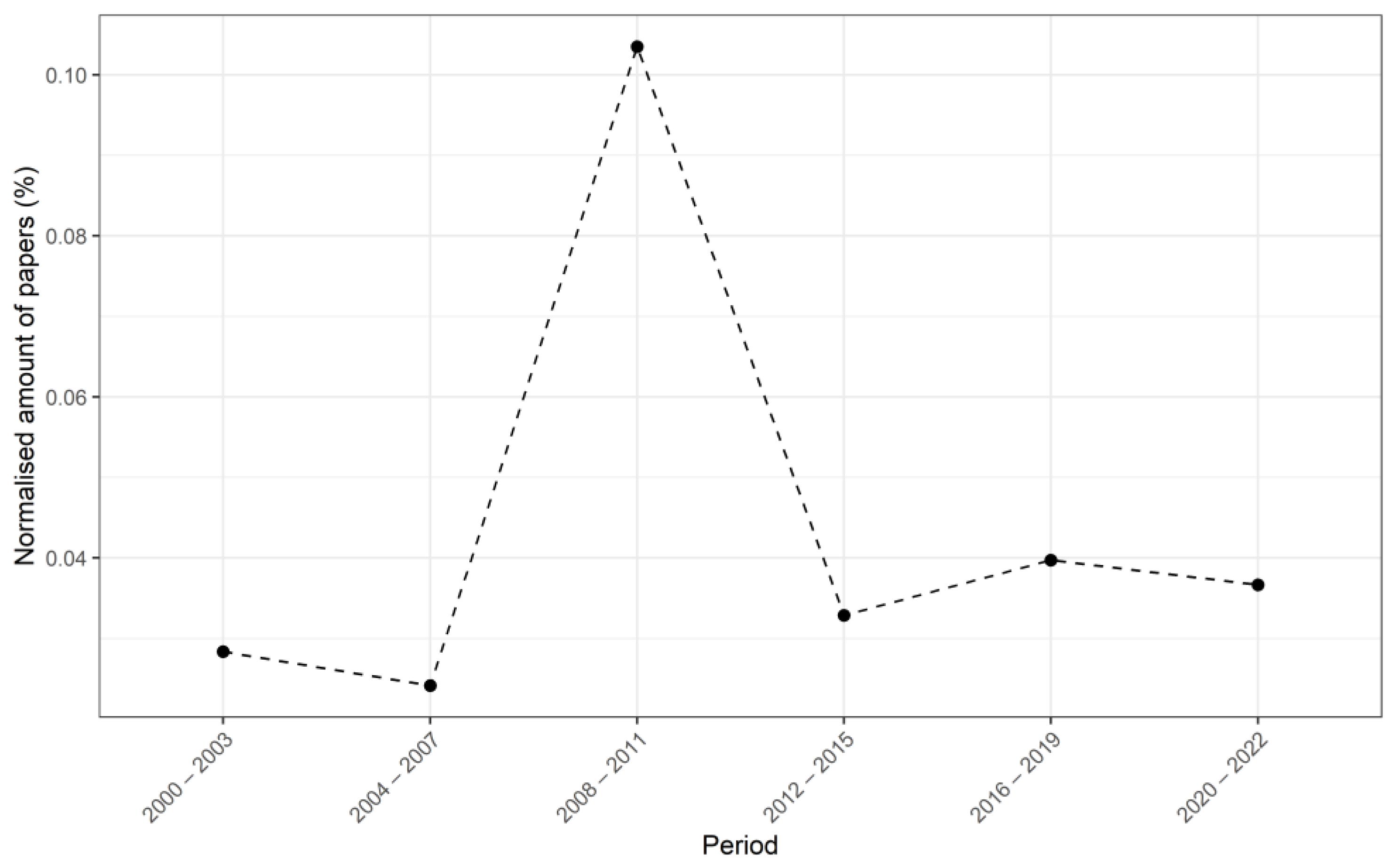
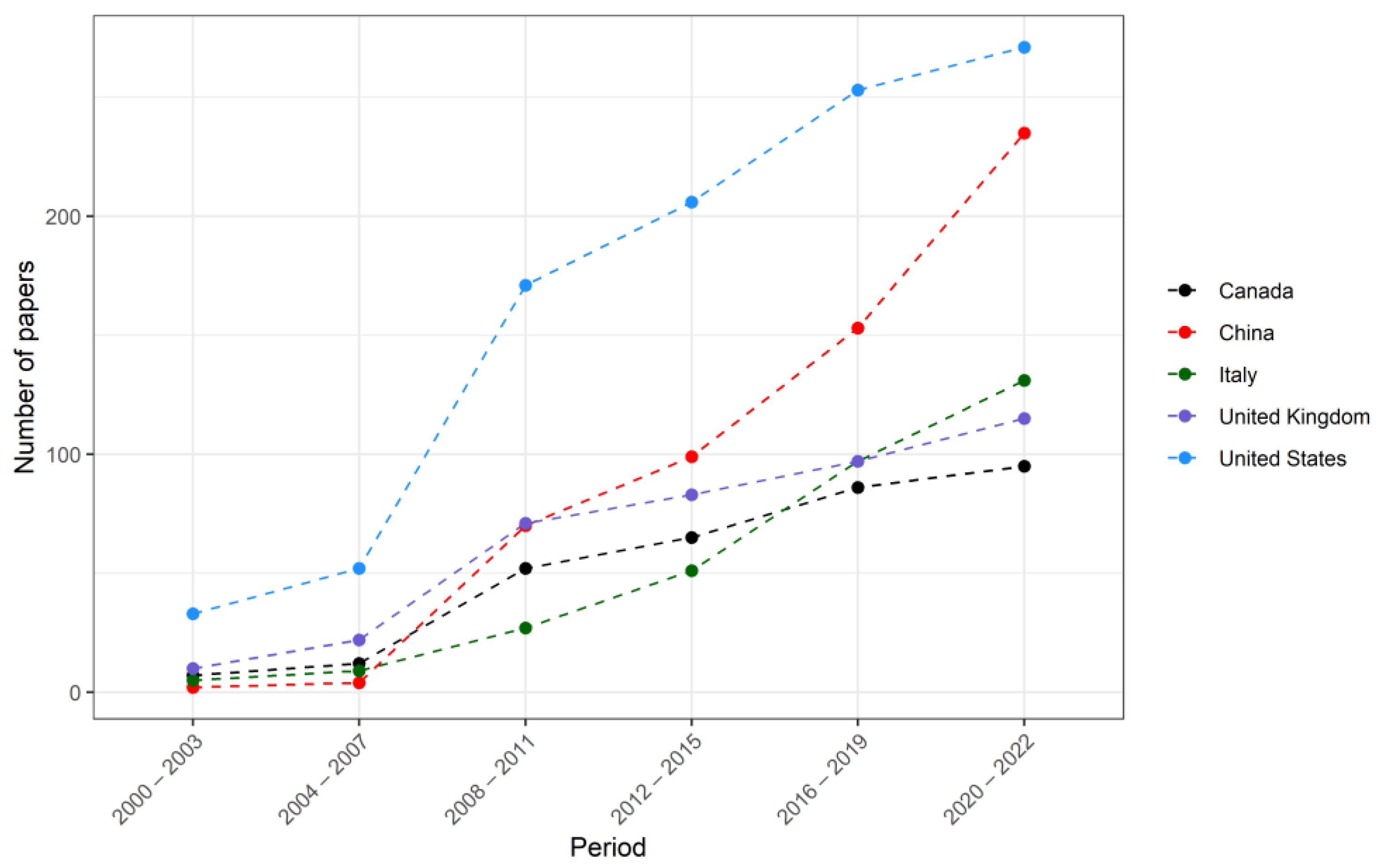
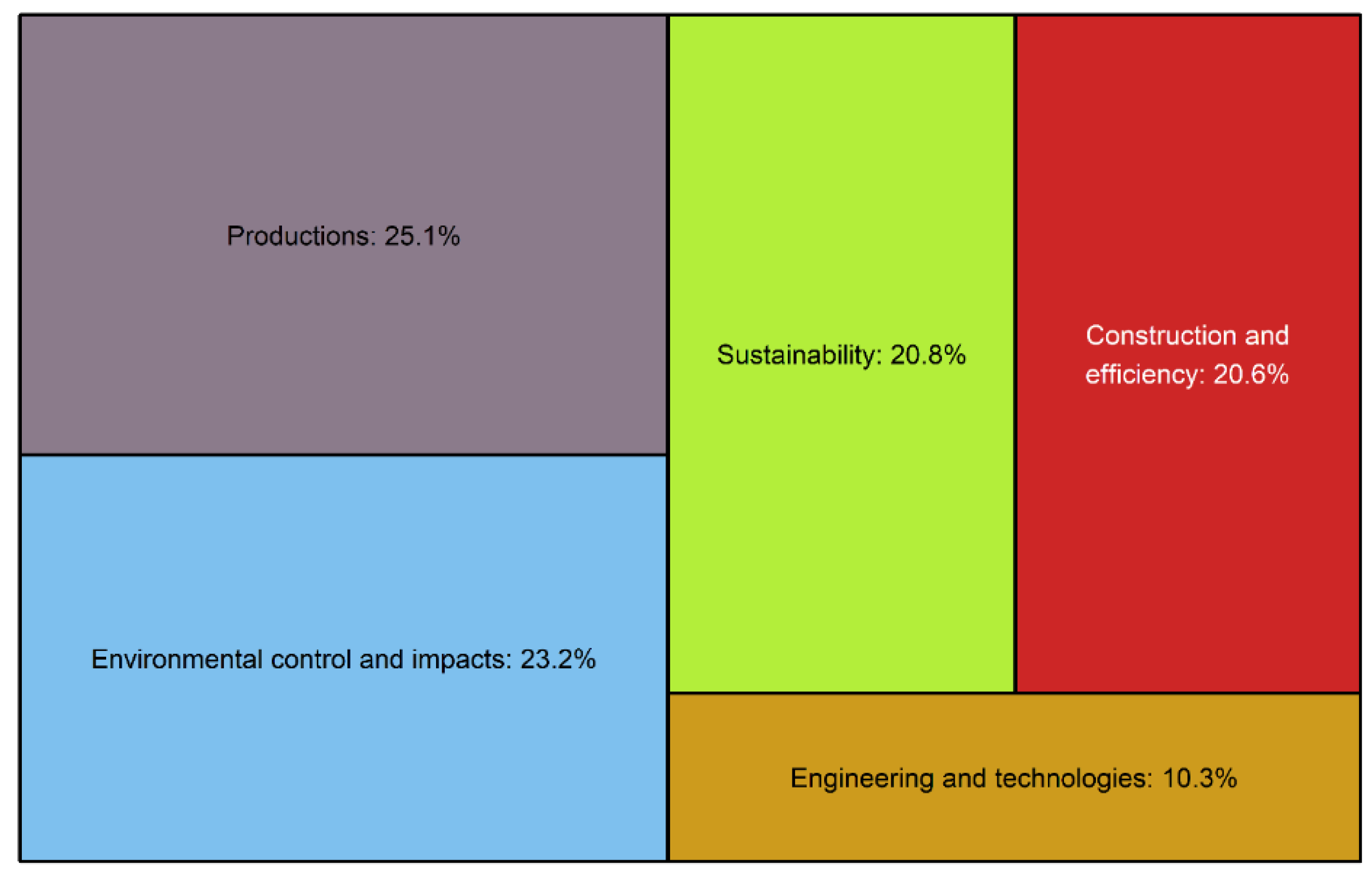
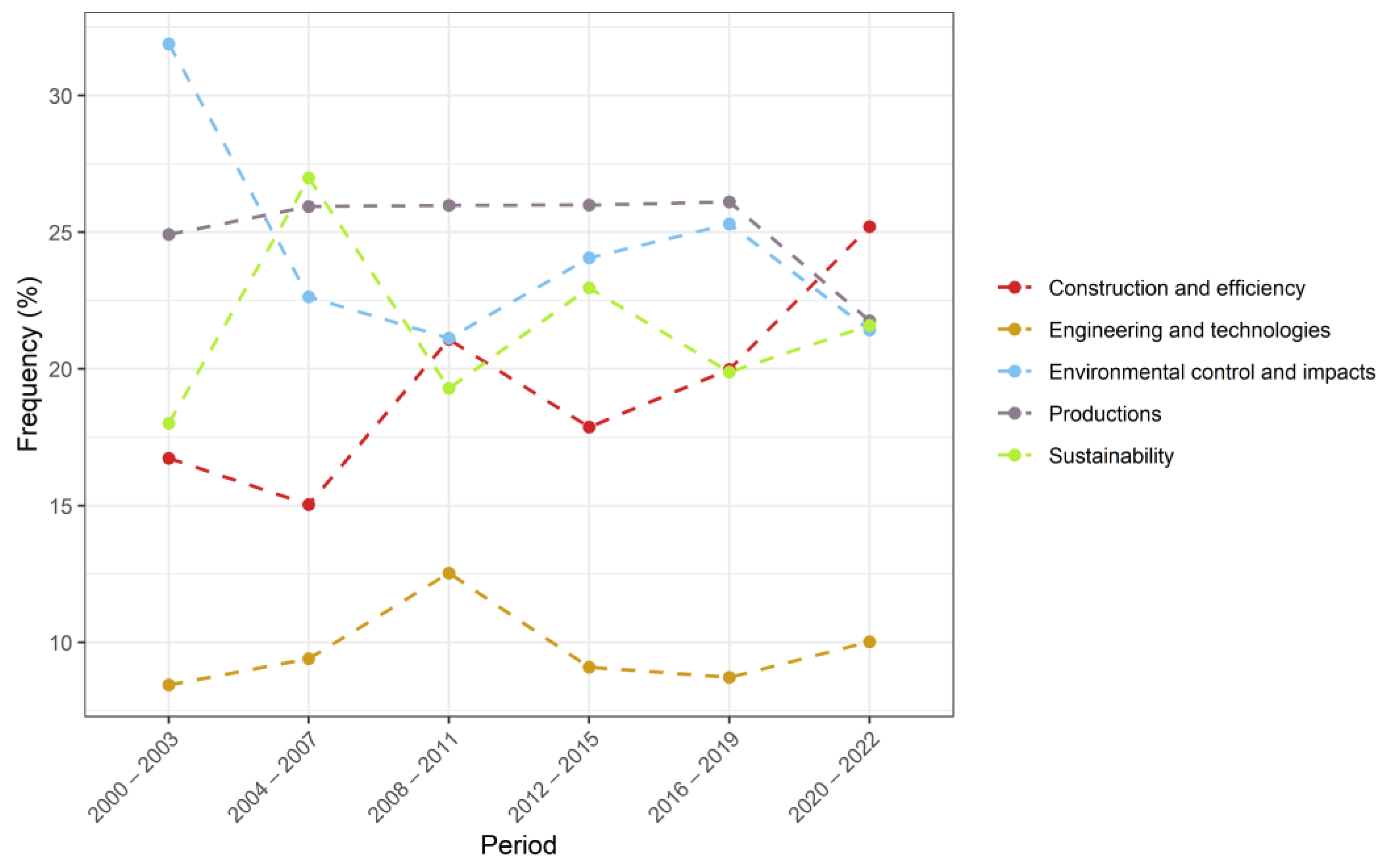
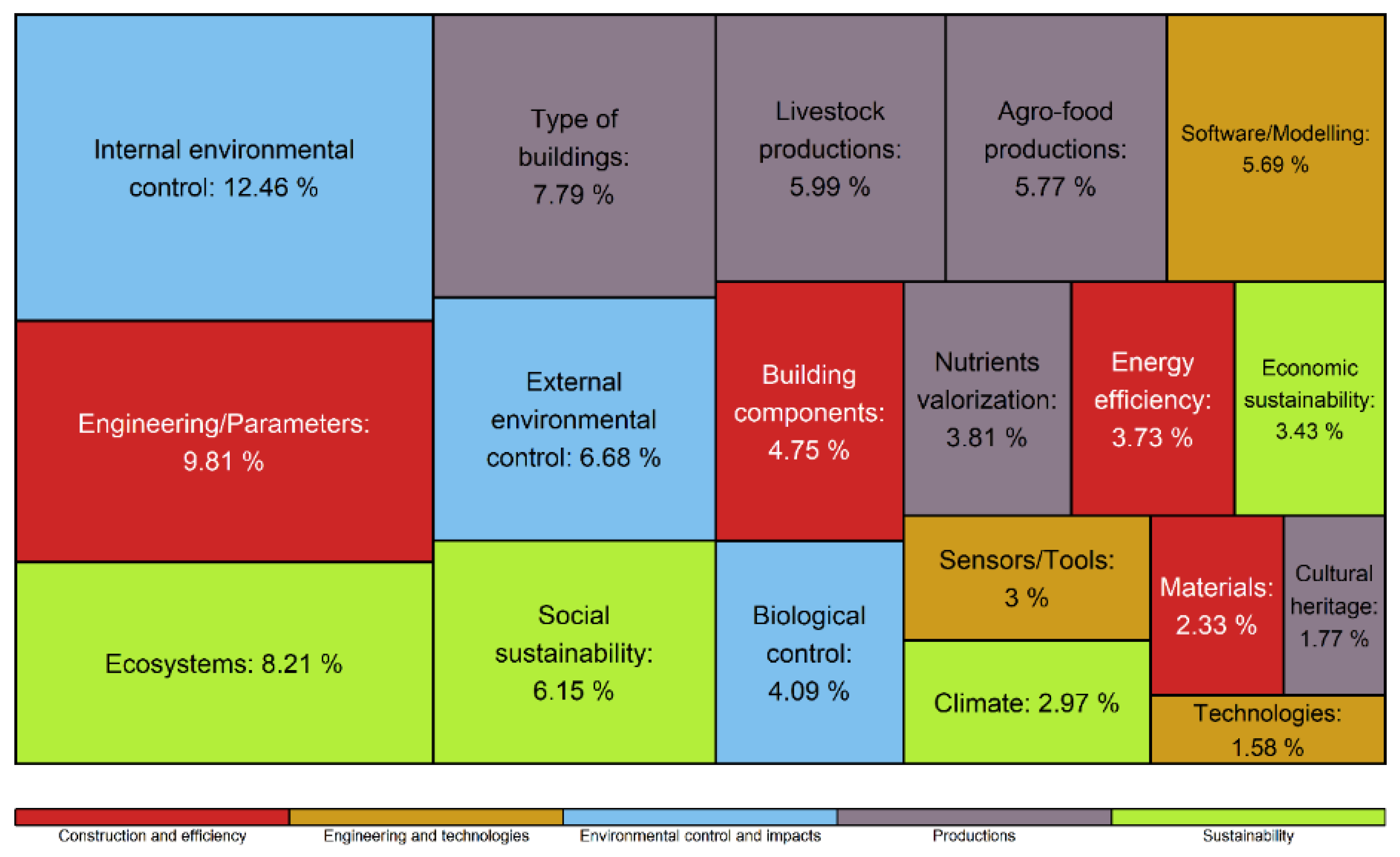
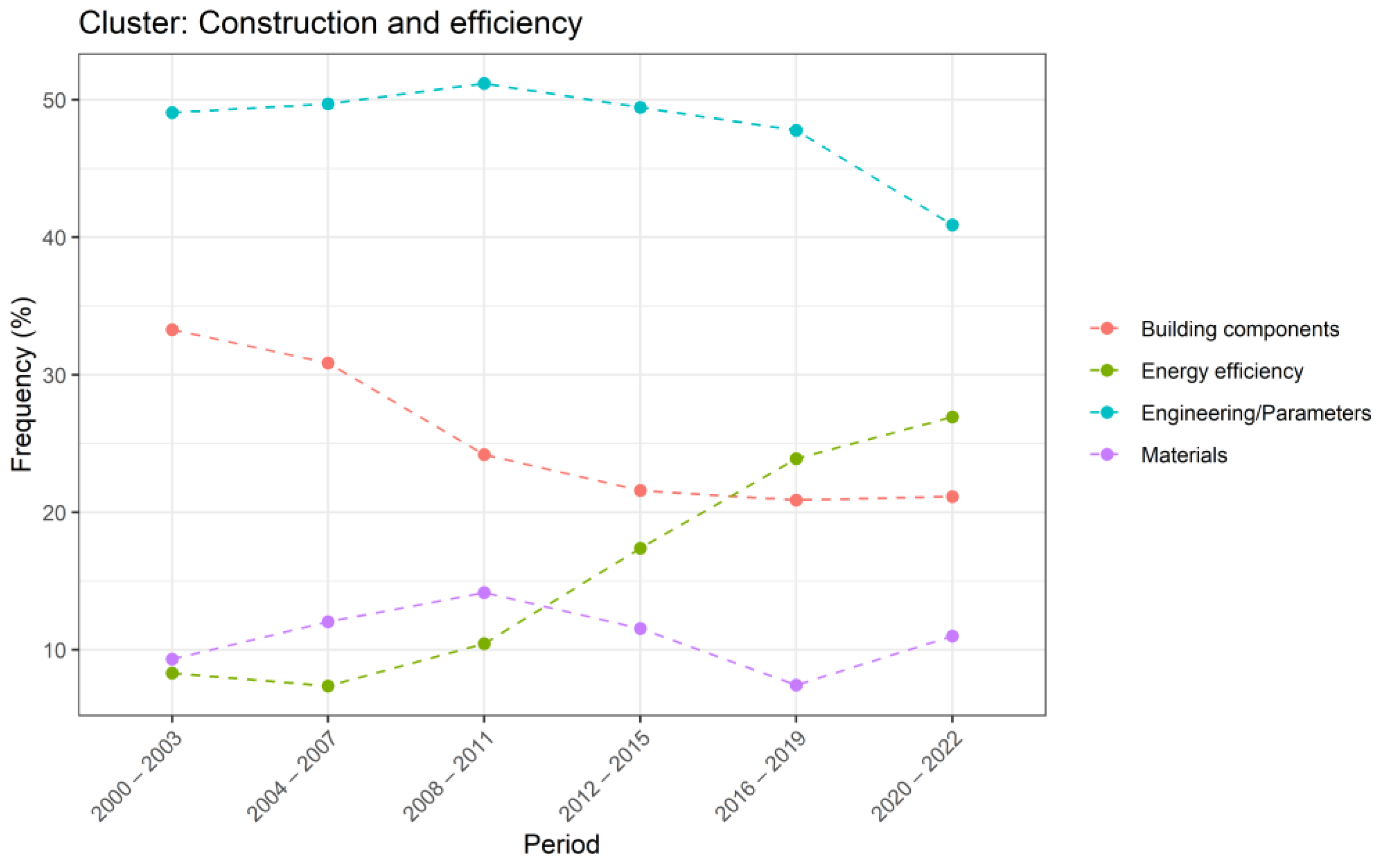
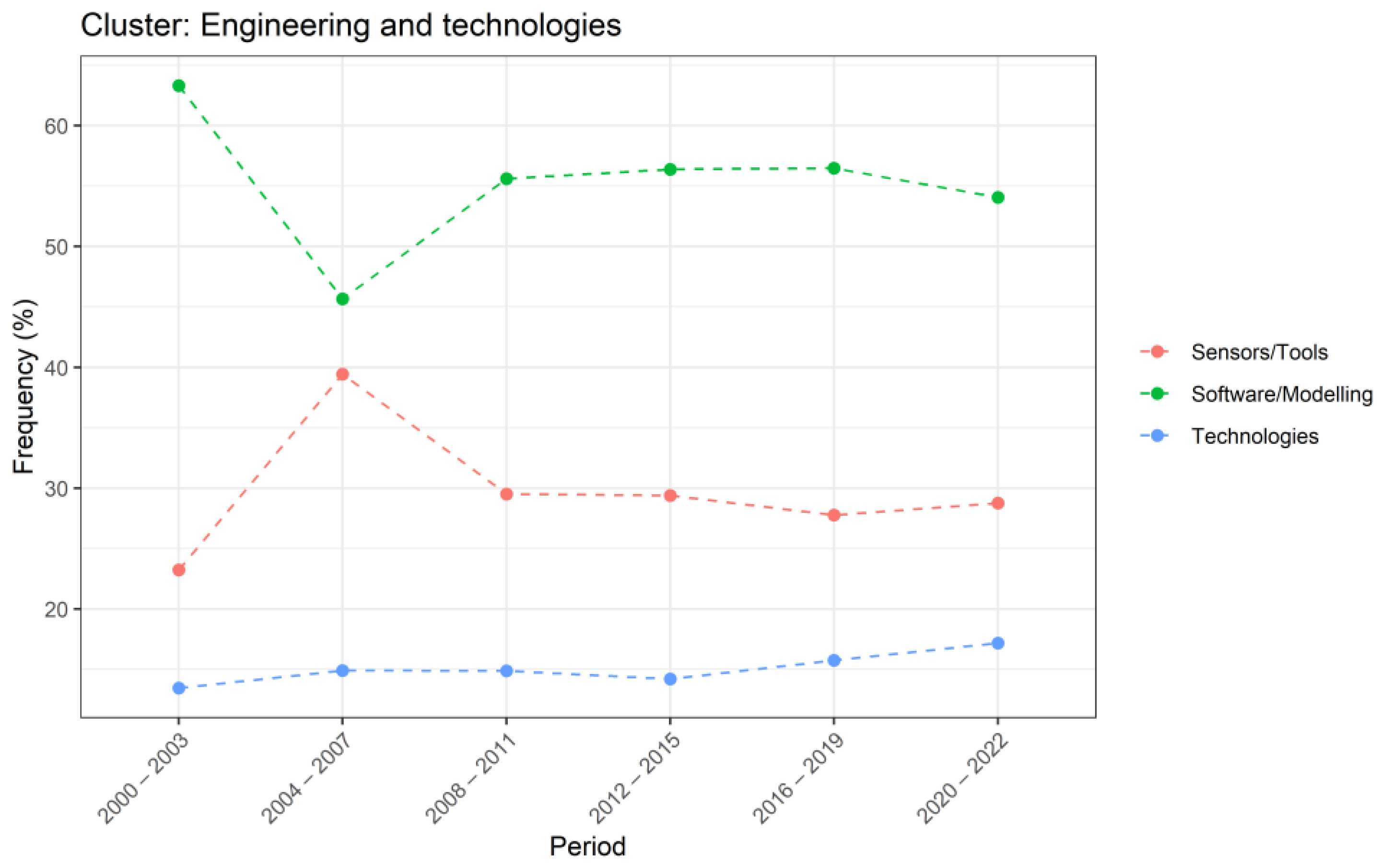
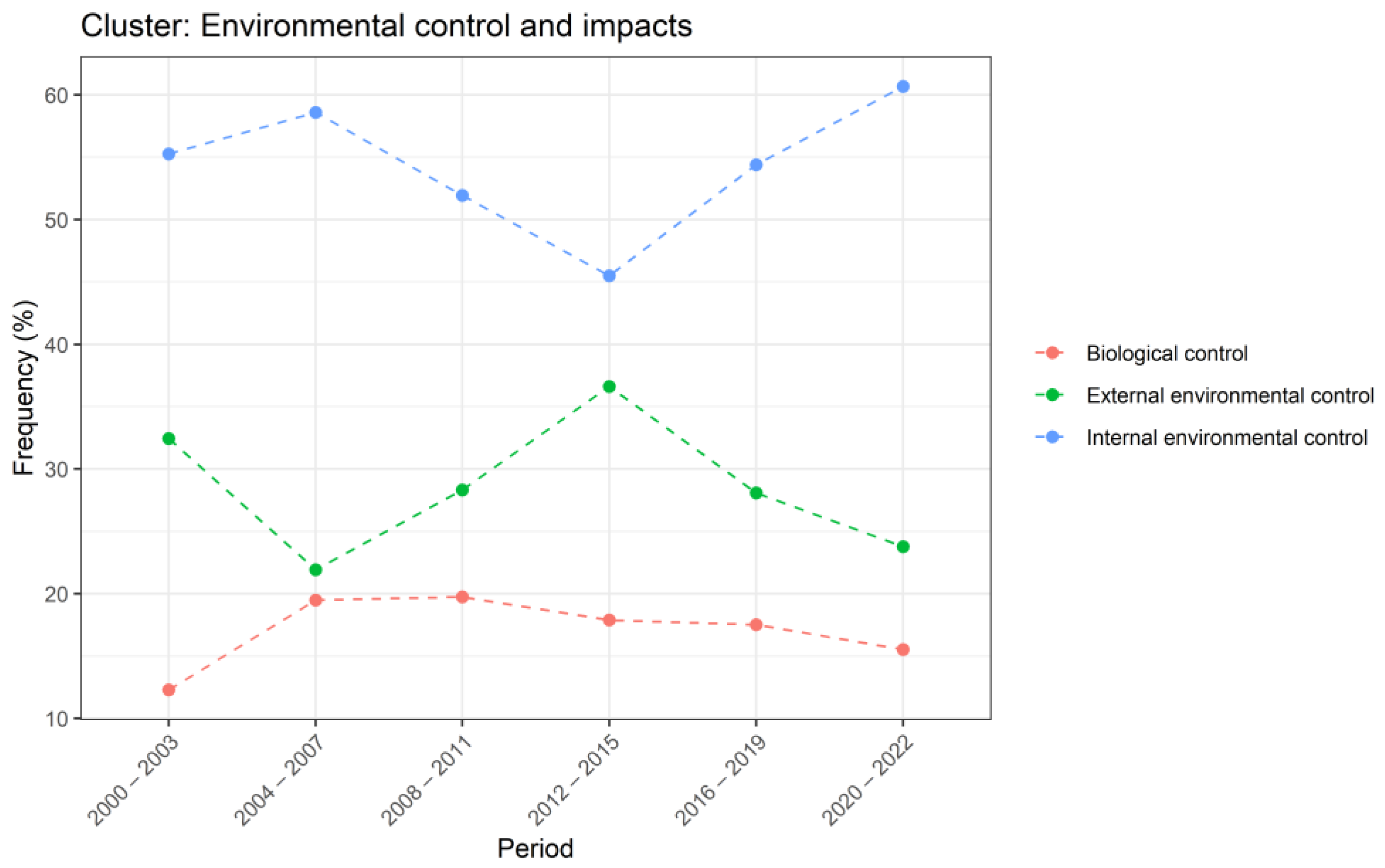
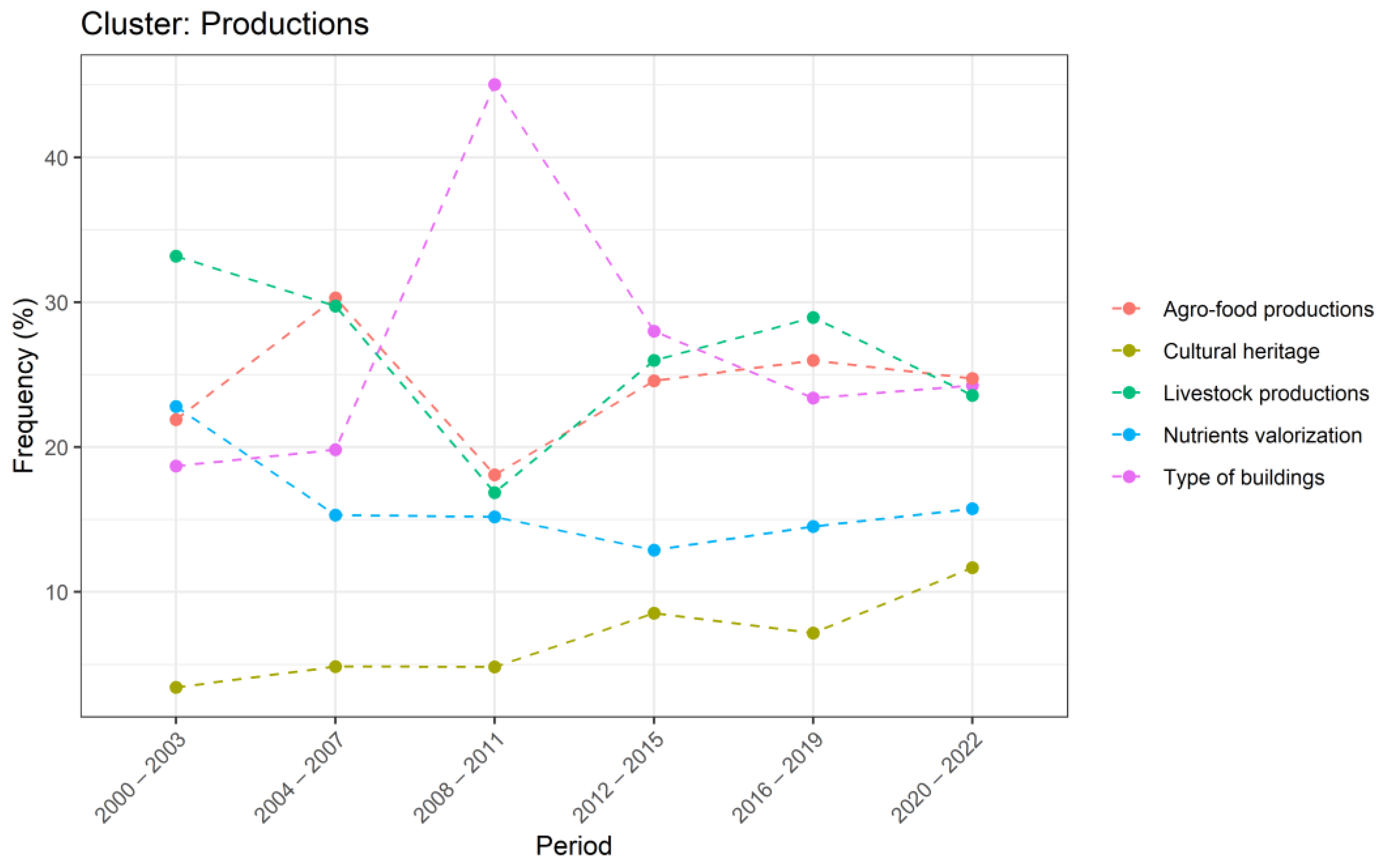

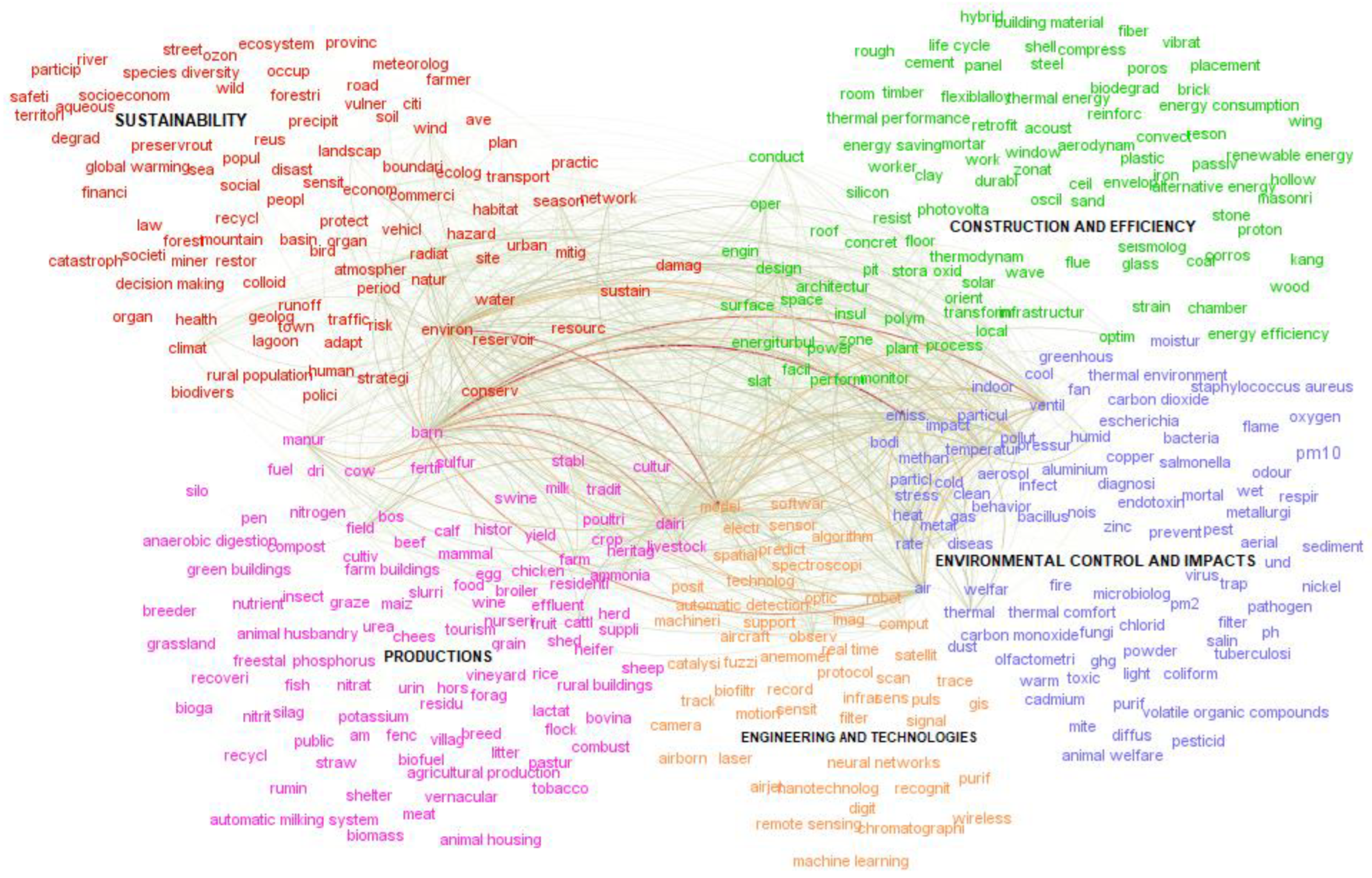
| Database | Search Query |
|---|---|
| SCOPUS | (TITLE-ABS-KEY (“agricultural building”) OR TITLE-ABS-KEY (“rural building”) OR TITLE-ABS-KEY (“rural buildings”) OR TITLE-ABS-KEY (“agricultural buildings”) OR TITLE-ABS-KEY (“farm building”) OR TITLE-ABS-KEY (“farm buildings”)) AND PUBYEAR > 1999 AND PUBYEAR < 2023 AND (LIMIT-TO (LANGUAGE, “English”)) AND (LIMIT-TO (SRCTYPE, “j”)) AND (LIMIT-TO (DOCTYPE, “ar”) OR LIMIT-TO (DOCTYPE, “re”)) |
| Topic | Summary of Reviews | Year | Reference |
|---|---|---|---|
| Construction and efficiency | Durability of timber structures | 2000 | [43] |
| Durability of metal structures | 2000 | [44] | |
| Snow load requirements of rural buildings | 2002 | [45] | |
| Pole building construction in the farm sector | 2004 | [46] | |
| Energy use and reduction in the building sector | 2010 | [47] | |
| Economic convenience of photovoltaic systems in Italian farm buildings | 2013 | [48] | |
| Sheep wool fibers as building components | 2020 | [49] | |
| Investigation on durability and corrosion of materials for farm buildings | 2020 | [38] | |
| Thermal and acoustic insulation panels | 2021 | [50] | |
| Engineering and technologies | Solid-state NMR spectroscopy | 2008 | [51] |
| Formation of the stable cluster phase in colloidal suspensions | 2009 | [52] | |
| Numerical methods to solve engineering problems | 2015 | [53] | |
| Cost-benefits of sensors used for structural health monitoring | 2021 | [36] | |
| Environmental control and impacts | Improving fire protection in agricultural buildings | 2003 | [54] |
| Ventilation design of agricultural buildings | 2004 | [55] | |
| Grazing management to reduce the potential for badger cattle contact | 2010 | [56] | |
| Particulate matter in livestock production systems | 2010 | [57] | |
| Volatile organic compounds in swine buildings | 2012 | [58] | |
| Air pollutants in swine buildings | 2012 | [59] | |
| Indoor environment monitoring | 2018 | [34] | |
| Passive cooling systems for livestock buildings | 2019 | [35] | |
| Meta-analysis of measured ammonia and methane emissions from dairy barns | 2021 | [60] | |
| Effects of climate control on intensive livestock farming | 2021 | [61] | |
| Computational Fluid Dynamics (CFD) studies applied to greenhouses and livestock buildings | 2022 | [62] | |
| Productions | Rural buildings as a source of historical evidence | 2005 | [33] |
| Investigation of archaeological Australian rural buildings | 2008 | [63] | |
| Alpine summer farms as an element of cultural heritage | 2010 | [64] | |
| Anaerobic digestion in Indian farm buildings | 2010 | [65] | |
| Architectural details of vernacular buildings | 2012 | [66] | |
| Most used methods to quantify ammonia emissions from fertilisers | 2020 | [67] | |
| Analysis of different typologies of rural buildings | 2022 | [1] | |
| Sustainability | Sustainable reuse of derelict rural buildings | 2004 | [68] |
| Gasifiers functionality | 2008 | [69] | |
| Lean methane combustion | 2008 | [70] | |
| Stable water isotope simulation in reservoirs | 2009 | [71] | |
| Impact of climate change on intensively housed livestock | 2011 | [72] | |
| Flood damage to agriculture, including buildings | 2013 | [73] | |
| Barn owl behaviour in a rural environment | 2015 | [74] | |
| Traditional materials in farm buildings to increase sustainability | 2016 | [37] | |
| Ecological surveys for badger activity monitoring | 2017 | [75] | |
| Adsorptive desulfurisation of liquid fuels and regeneration attempts | 2022 | [76] |
| Sub-Clusters | Main Stems and Relative Occurrence | Cluster Weight (%) |
|---|---|---|
| Engineering/Parameters | design (12.6%); perform * (11.3%): process * (10.1%); monitor * (6.0%); oper * (5.5%) | 46.8% |
| Building components | surfac * (16.3%); storag * (11.2%); local * (10.7%); floor (9.4%); space (6.7%) | 23.2% |
| Energy efficiency | energ * (39.7%); solar (14.2%); power (10.1%); energy consumption (7.7%); insul * (5.6%) | 18.2% |
| Materials | concret * (14.2%); wood (7.6%); polym * (7.0%); steel (6.4%); masonry (5.8%) | 11.8% |
| Sub-Clusters | Main Stems and Relative Occurrence | Cluster Weight (%) |
|---|---|---|
| Software/Modelling | model * (41.4%); comput * (10.7%); predict * (7.4%); spatial (7.2%); algorithm (6.7%) | 55.9% |
| Sensors/Tools | observ * (17.3%); posit * (12.9%); imag * (11.8%); sensor (11.2%); support (6.7%) | 28.4% |
| Technologies | technolog * (23.4%); electr * (19.0%); spectroscop * (9.8%); airborn (9.3%); filter (8.3%) | 15.7% |
| Sub-Clusters | Main Stems and Relative Occurrence | Cluster Weight (%) |
|---|---|---|
| Indoor Environmental Control | air (17.1%); temperature (12.7%); heat (11.6%); ventil * (10.9%); thermal (6.9%) | 54.0% |
| External Environmental Control | emiss * (28.8%); pollut * (12.0%); gas (10.2%); impact (8.8%); particl * (7.7%) | 28.5% |
| Biological Control | rate (24.4%); stress (8.8%); diseas * (8.6%); behavior (6.5%); bodi (5.1%) | 17.4% |
| Sub-Clusters | Main Stems and Relative Occurrence | Cluster Weight (%) |
|---|---|---|
| Type of buildings | stabl * (33.5%); barn (28.5%); farm buildings (21.7%); rural buildings (8.9%); resident (2.7%) | 31.1% |
| Livestock productions | livestock (11.9%); swine (10.2%); cow (10.1%); cattl * (9.0%); poultry (6.5%) | 23.9% |
| Agro-food productions | farm (35.2%); dairy (22.4%); field (12.2%); food (5.3%); dri * (4.1%) | 22.7% |
| Nutrients valorisation | manur * (21.6%); ammonia (19.1%); nitrogen (9.5%); sulfur * (5.3%); biofuel (4.7%) | 15.1% |
| Cultural heritage | tradit * (23.2%); cultur * (18.4%); history (14.1%); heritage (11.0%); villag * (10.2%) | 7.2% |
| Sub-Clusters | Main Stems and Relative Occurrence | Cluster Weight (%) |
|---|---|---|
| Ecosystems | environ * (20.9%); water (14.2%); natur * (7.6%); soil (6.6%); site (5.7%) | 39.5% |
| Social sustainability | landscap * (9.6%); network (8.8%); human (7.4%); organ * (7.3%); urban (7.2%) | 30.0% |
| Economic sustainability | plan (13.7%); econom * (13.0%); risk (11.6%); strateg * (8.6%); damage (8.1%) | 16.2% |
| Climate | wind (23.2%); period (15.2%); climat * (15.1%); season (14.3%); atmosphere (12.4%) | 14.3% |
Disclaimer/Publisher’s Note: The statements, opinions and data contained in all publications are solely those of the individual author(s) and contributor(s) and not of MDPI and/or the editor(s). MDPI and/or the editor(s) disclaim responsibility for any injury to people or property resulting from any ideas, methods, instructions or products referred to in the content. |
© 2023 by the authors. Licensee MDPI, Basel, Switzerland. This article is an open access article distributed under the terms and conditions of the Creative Commons Attribution (CC BY) license (https://creativecommons.org/licenses/by/4.0/).
Share and Cite
Cogato, A.; Cei, L.; Marinello, F.; Pezzuolo, A. The Role of Buildings in Rural Areas: Trends, Challenges, and Innovations for Sustainable Development. Agronomy 2023, 13, 1961. https://doi.org/10.3390/agronomy13081961
Cogato A, Cei L, Marinello F, Pezzuolo A. The Role of Buildings in Rural Areas: Trends, Challenges, and Innovations for Sustainable Development. Agronomy. 2023; 13(8):1961. https://doi.org/10.3390/agronomy13081961
Chicago/Turabian StyleCogato, Alessia, Leonardo Cei, Francesco Marinello, and Andrea Pezzuolo. 2023. "The Role of Buildings in Rural Areas: Trends, Challenges, and Innovations for Sustainable Development" Agronomy 13, no. 8: 1961. https://doi.org/10.3390/agronomy13081961
APA StyleCogato, A., Cei, L., Marinello, F., & Pezzuolo, A. (2023). The Role of Buildings in Rural Areas: Trends, Challenges, and Innovations for Sustainable Development. Agronomy, 13(8), 1961. https://doi.org/10.3390/agronomy13081961









